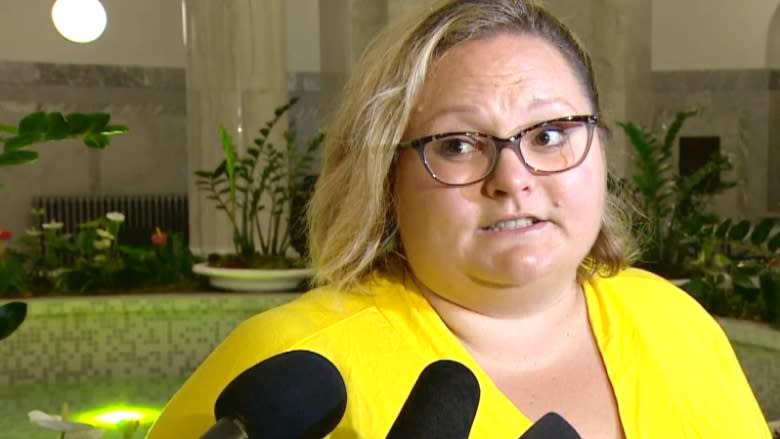Alberta health minister slams dental association over new fee guide
A new fee guide for dental services in Alberta doesn't go far enough to reduce patients' costs, a "disappointed" Health Minister Sarah Hoffman said Thursday.
Hoffman told reporters that the Alberta Dental Association and College didn't share details of the new guide with her before making it public earlier in the day.
She said she is examining "rather extreme measures," including the possibility of separating the dental association from the regulatory functions, if the ADA&C doesn't meet her expectations to make dental services more affordable for Albertans.
"If they don't [meet expectations] we'll certainly have to have discussions about some of those sharper tools, or bigger tools, in my toolbox," Hoffman said.
The minister said she was "disappointed how they didn't share this guide with me ahead of time," adding: "If they had I certainly would have expressed my desire to see them go much further, and would be able to stand with them in celebrating the big steps that have been made."
Dr. Mintoo Basahti, president of the ADA&C, told CBC's Radio Active later on Thursday that the association is willing to do further work on the fee structure, which he said represents higher costs of operations in Alberta.
"We feel we've struck a middle ground but we still look forward to continuing discussions with Minister Hoffman and her team," he said.
The Alberta government announced last December that a new fee guide would be created to try to rein in skyrocketing dental costs.
Hoffman said the government received an email about the guide Thursday morning that she has yet to "personally receive." Basahti apologized for any miscommunication.
"We've been looking for a face-to-face meeting with the minister for the last two months and it just hasn't happened. I have a funny feeling that we'll probably have one pretty quickly."
Recommended Alberta fees higher than in B.C.
The Alberta fee guide recommends a standard oral examination for a new patient be priced at $75.36, compared to the suggested $43.10 fee in British Columbia. Returning patients should pay $70.75 for oral exams, compared to $27.70 in B.C., the guide says.
Hoffman said she isn't satisfied with the relationship between the NDP government and the ADA&C. She said she has more productive dealings with other professional associations.
"I'm really proud of the progress we've made with the Alberta Medical Association. We sat down, we negotiated and we got $500 million back on the table for taxpayers, for Albertans, and that money is able to focus on other areas of need in health care.
"That, frankly, was the kind of relationship I was hoping we'd be able to achieve here [with the dental association]."
The way to fix things, Hoffman said, is for the college to work harder to get costs lower.
"That is still my expectation. I look forward to further discussions with them on how they are going to approach that."
Albertans currently pay more for dental services than any other Canadians.
For the past 20 years, there has not been a fee guide in Alberta. Dentists are free to set their prices at whatever level they choose.
Earlier Thursday at a news conference in Edmonton, Basahti said the new fee guide should put "downward pressure" on costs.
But Alberta Blue Cross, which is the largest insurer of dental payments in the province, said a two- or three-per-cent reduction doesn't go far enough. In a release, it notes costs in Alberta are 26 to 32 per cent higher than the other Western provinces.
"A small reduction may be more about making news headlines than making a real difference for Albertans," the Alberta Blue Cross news release said.
The executive director of Friends of Medicare, Sandra Azocar, was similarly critical.
"A mere three-per-cent reduction being proposed will do nothing to address the issues of affordability which currently prevents Albertans from accessing dental care," she said.
Lower earnings for dentists likely
The guide, covering more than 1,800 procedures, will likely result in lower earnings for Alberta's 2,600 dentists and others who work in the industry, Basahti said. The guide reflects Alberta's challenging economic environment, he said.
'This new guide is really going to help us to put downward pressure on these fees," he said. "If I had to make a definitive statement I would say yes, dentists are going to be making less."
The guide, published on the ADA&C website, is not a rigid set schedule of fees. Dentists won't have to abide by the guide fees but competition will help drive down what patients pay for services, Basahti predicted.
Dentists who see that they are charging more than the fee guide recommends for certain procedures "are going to want to come down closer to that if they're above it," he said.
Patients will benefit from the increased transparency, he said. The guide will be a "tool for communication" between patients and their dentists.
"I think this will give everyone a playbook to work from which we just haven't had in Alberta for a long time," Basahti said. "We want to be able to lower costs for patients, ultimately, and then we need to be able to run our practices more efficiently in order to support those new fees. But that doesn't happen overnight."
The December announcement that a fee guide would be created grew out of a review of Alberta's $1.5-billion dental industry, completed in early 2016.
The review confirmed that Alberta dental fees were higher than anywhere else in Canada, and increasing at a faster pace than in any other part of the country. The review noted that business operating costs tend to be higher in Alberta, primarily due to higher labour costs.
Basahti said the ADA&C's next step will be to develop programs for "vulnerable" Albertans who can't afford dental services.
Dentists who have contracts for government-funded programs have agreed to a zero-per-cent increase in their contracts over two years, he noted.



